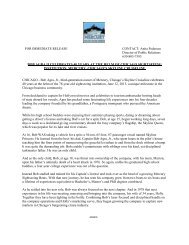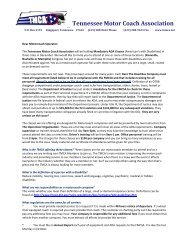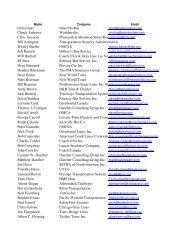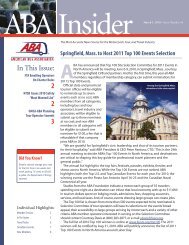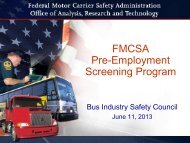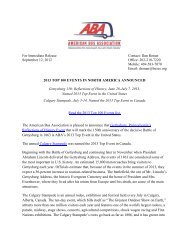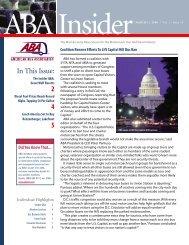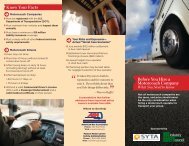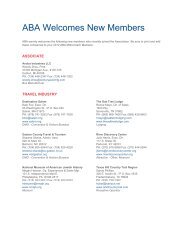The Intercity Bus Rolls To Record Expansion – 2011 Update On
The Intercity Bus Rolls To Record Expansion – 2011 Update On
The Intercity Bus Rolls To Record Expansion – 2011 Update On
Create successful ePaper yourself
Turn your PDF publications into a flip-book with our unique Google optimized e-Paper software.
Key Findings1. <strong>The</strong> intercity bus was the sole major long-distance passenger transportation mode that grewappreciably in <strong>2011</strong>. Daily bus operations expanded by 7.1%, a marked increase in theannual growth from previous years.2. “Curbside operators,” led by Bolt<strong>Bus</strong> and Megabus, grew at a particularly rapid rate,expanding the number of departures from 589 to 778, a 32.1% increase.3. Passenger traffic on curbside operators grew by approximately 30%. In absolute terms, webelieve this represents the largest expansion of passenger traffic on curbside operatorssince the sector emerged as a significant transportation mode in 2006.4. Evidence suggests that the two largest Megabus.com hubs, Chicago and New York, arenow profitable, indicating that the core business model is financially sustainable.1
Table 1:Service Changes on Greyhound Express Routes<strong>To</strong>tal Daily Trips (In direction indicated):Route November 2010 December <strong>2011</strong>Atlanta – Savannah 4 4 (includes 2 Express)Chicago – Indianapolis 6 9 (includes 3 Express)Chicago – St. Louis 5 7 (includes 3 Express)Chicago – Twin Cities 5 8 (includes 5 Express)New York – Washington, D.C. 19 18 (includes 11 Express)Philadelphia – Pittsburgh 5 8 (includes 3 Express)Source: Russell’s Official National Motor Coach GuideStation and Amenity Enhancements: Conventional bus lines invested heavily in newstations and conveniences. <strong>The</strong> unveiling of Greyhound’s new LEED certified terminal inSacramento, the largest station the carrier has built in years, is particularly newsworthy. <strong>The</strong>sale of its station in the nation’s capital and relocation of operations to Washington UnionStation (which also serves as the Megabus terminal) similarly reflects the carrier’s heightenedefforts to modernize its facilities. <strong>The</strong> carrier also entered a partnership with 7-11 stores to allowpassengers to pick up tickets and pay with cash without traveling to (or arriving early at) the busstation. In addition, Greyhound installed power outlets on many more buses and invested in newwaiting areas for Express passengers.Selected additions and reductions by smaller carriers: Smaller conventional buscompanies were also on the move this year, with Jefferson Lines particularly ambitious,expanding (by our estimate) from 51 weekday departures in 2010 to 70 in <strong>2011</strong>. <strong>The</strong> carrieradded a new express service on the Minneapolis to Fargo route and developed a “Rocket RiderService” that shortened travel time from Minneapolis to Duluth, Kansas City, and Fargo on Wi-Fiequipped buses.Prestige <strong>Bus</strong> Lines launched its BeeLine Express over two routes from Wichita, KS toPueblo, CO and Salina, KS, complementing its services provided in conjunction withGreyhound. Peoria Charter Coach, an Illinois-based company, added a new route with six dailytrips from Champaign to Normal, IL, and on to Chicago’s major airports, bringing the weekdaytotal to 17 departures.A variety of service reductions also took place. Last summer, Runways Transportation,for example, ceased operations, ending its service from the Jacksonville and Orlando airports(with stops in Gainesville and other cities) due to increasing gas prices and decreasingpassenger travel. Various Trailways lines also marginally reduced service in <strong>2011</strong>.2) Curbside operators expanded daily bus operations by 32.1% in <strong>2011</strong>, primarily due tothe addition of three new hubs. Curbside operators now account for 778 daily busoperations in the continental United States, up from 589 last year.<strong>The</strong> significant growth of curbside services was attributed primarily to the creation of threenew hubs and incremental expansion from established hubs. Curbside operators, which avoidtraditional stations in favor of curbside pickup while emphasizing internet ticketing and express4
New Megabus and Bolt<strong>Bus</strong> Hubs: <strong>On</strong> May 11, <strong>2011</strong>, Megabus established its fifthhub in Pittsburgh, instituting a stronger market presence in the densely populated regionbetween the East Coast and Midwest (Figure 1). This hub offers 38 weekday arrivals anddepartures, although its creation resulted in only two new cities, Akron, OH and Erie, PA, beingadded to the route network, with the remainder of other cities in the region already being servedfrom hubs in Chicago, New York, Philadelphia, and Washington, D.C.<strong>On</strong> June 14, Bolt<strong>Bus</strong> created a new hub in Newark, offering nonstop service toBaltimore, Boston, Philadelphia, and Washington, D.C (Figure 2). This hub, with 40 daily busoperations, is less than 20 miles from the carrier’s New York hub, enhancing that carrier’salready-strong position in the metropolitan region. <strong>The</strong> two hubs are entirely distinct operations.<strong>On</strong> November 16, Megabus commenced operation in Atlanta, establishing thecompany’s lone connecting point south of the Mason Dixon line. (<strong>The</strong> carrier briefly operated ahub in Los Angeles starting in 2007 but ceased operations soon after). <strong>The</strong> Atlanta hub has 29daily arrivals and departures serving 11 cities: Birmingham, Charlotte, Chattanooga, Gainesville,Jacksonville, Knoxville, Memphis, Mobile, Montgomery, Nashville, and Orlando. All but three ofthese cities are new to the Megabus system. Megabus also added routes from Boston toBurlington, VT, Hartford, CT, and New Haven, CT, thus creating a mini-hub in theMassachusetts city.Figure 3: Route Map of Bolt<strong>Bus</strong>’ Newark HubWith Frequency of Service in Each DirectionSchedules effective December <strong>2011</strong> for travel on Friday, Jan. 6, 2012Incremental <strong>Expansion</strong>s at Existing Curbside Hubs: <strong>Expansion</strong> at establishedMegabus hubs included new Chicago to Omaha and New York City to Binghamton, NY service,as well as trips from Memphis to St. Louis. Bolt<strong>Bus</strong> added Philadelphia to Boston service viaNewark, thus following the lead of Megabus by establishing routes bypassing New York City.6
<strong>The</strong>se expansions and the new hubs brought the number of daily Bolt<strong>Bus</strong> and Megabusdepartures to 202 and 460, respectively.Smaller Curbside Operators: Smaller curbside operators also expanded, particularlyin the Northeast. By our latest count, there are now at least eight such carriers, not includingChinatown operators. Several of these operators, including Limoliner, Lux <strong>Bus</strong> America, andNew York Shuttle, offer enhanced amenities in spacious seat configurations. <strong>The</strong> number ofdaily bus operations on these carriers, however, remains relatively small (Figure 2).Table 2:Daily Operations by Smaller Curbside OperatorsWeekday Departures, December <strong>2011</strong><strong>Bus</strong> OperationsDailyRoutesCalifornia Shuttle <strong>Bus</strong> 4 Los Angeles – San FranciscoDC2NY <strong>Bus</strong> 12 New York – Washington/No. VirginiaLimoliner 6 Boston – New YorkLux <strong>Bus</strong> America 2 Los Angeles – Las VegasTripper <strong>Bus</strong> 16 New York – Bethesda, MD/No. VirginiaNew York Shuttle 2 Charlottesville, Virginia – New YorkVamoose 24 New York – Washington D.C. areaWashington Deluxe 18 New York – Washington, D.C.*Based on ticketing in December <strong>2011</strong> and for travel on Friday, January 6, 2012In the West, USAsia <strong>Bus</strong> Lines grew dramatically in <strong>2011</strong> but is not included in thesecounts since it is a Chinatown service. i Curbside service is not yet available between pointswest of Omaha, and east of Las Vegas. Although conventional operators and lines orientedtoward airport or casinos passengers provide scheduled service—with some routes extendinghundreds of miles—the absence of curbside routes, defined as running downtown to downtown,is noteworthy. Megabus has expressed interest in serving Texas or returning to California buthas made no moves toward this effort in the past year.3) <strong>The</strong> intercity bus was the only intercity mode to grow appreciably in <strong>2011</strong>, making itthe fastest growing form of intercity transportation for the fourth year in a row.This marks the fourth consecutive year that scheduled bus service grew faster thanother modes of intercity transportation. <strong>The</strong> capacity of schedule operators on most modes oftransportation systems remained virtually unchanged.Airlines slightly reduced flight departures, decreasing scheduled offerings by .34%through October (the most recent month for which data is available), while modestly increasingthe number of available seat miles over this period by 1.5% (Figure 4). Rail services remainedvirtually unchanged, despite investments in higher-speed systems. Amtrak’s train-milesdeclined by 1.1% through October, while its seat-miles rose by 1.2%. As previously noted, theamount of bus service, measured by the number of departures, grew by 7.1%. (See Finding 4below for a discussion of changes in automobile travel, which has experienced a 1% year-overyeardecline). ii7
8.0%7.0%6.0%5.0%4.0%3.0%2.0%1.0%0.0%Figure 4:Changes in Service Level by Mode+7.1%Annual Change - <strong>2011</strong> vs. 2010+1.53%+1.16%Based on most recent data available. Airline and rail comparisons are year-to-date throughSept. 10 vs. same period previous year. <strong>Bus</strong> data is estimated year-to-date throughNovember 2010.<strong>The</strong> Chaddick Institute is currently measuring the number of bus-miles and route-milesoperated by curbside carriers to allow for a more refined analysis of capacity changes, but weanticipate that the rate of growth for these measures will be similar to the rate of growth for dailybus departures.4) <strong>The</strong> ridership on curbside buses during the 4th quarter of this year appears to be atleast 30% higher compared to the same period last year. Megabus has reported 28-35% ridership growth on the system in a major financial publication released onDecember 4, <strong>2011</strong>.Accurate passenger traffic statistics are not available for the intercity bus sector due tothe fact that no federal government agency compiles and audits such statistics, as is done forintercity rail and airplane travel. Greyhound has not yet reported its official traffic for <strong>2011</strong>; in2010, however, it reported carrying roughly 19 million passengers.Nevertheless, the evidence suggests that traffic for the industry has been robust.Megabus indicated in a December 4, <strong>2011</strong> interview in the Financial Times that in late <strong>2011</strong>, itsbookings were 28-35% ahead of last year. iii Other reports put the growth at dramatically higherrates. iv Liberum Capital projected that Megabus traffic would grow by 75% between thecalendar years 2010 and <strong>2011</strong> but that this growth rate would slow down to 29% in 2012. vWe believe that 30% is a conservative middle-ground estimate of the growth in curbsidetraffic between 2010 and <strong>2011</strong> (Figure 5). Amtrak and commercial airline passenger boardings8
were up far less, by 5.2% and 1.8% respectively, over the year-to-date. Automobile trafficdeclined by 1% through September. More recent data is not available.Year of year change in passenger boardings40%30%20%10%0%-10%Figure 5:Estimated Growth in Passenger Ridership+30%+5.2%<strong>2011</strong> vs. 2010+1.8% N/A-1.0%Based on most recent data available. Airline and rail comparisonsare year-to-date through Sept. 10 vs. same period previous year.<strong>Bus</strong> data is estimated year-to-date through November 2010.5) Megabus’s largest hubs, Chicago and New York, are reported to be profitable, whileBolt<strong>Bus</strong> appears to be, at a minimum, financially self-sustaining, if not also profitable.Financial disclosures by Stagecoach, the holding company of Coach USA, whichoperates most of the U.S. Megabus system, indicate that the Chicago and New York hubsenjoyed healthy profit margins, with cumulative profits of $13.6 million between April 2010 andApril <strong>2011</strong>. <strong>The</strong> operating margins for Chicago and New York, as reported by Liberum, were animpressive 22.7% and 18.6%, respectively. vi Although the carrier’s newer hubs in Philadelphiaand Atlanta had not yet broken even, the system as a whole was reported to be profitable.<strong>The</strong> financial performance of Bolt<strong>Bus</strong> and other curbside carriers have not beenpublically disclosed, although it is worth noting that Bolt<strong>Bus</strong> has operated without interruption fornearly four years, has a well-capitalized parent company, and has made gradual expansion toits overall system—all signs that they are doing well from a financial standpoint. A study byLiberium finds that once hubs become well-established, carriers benefit from both greaterpricing power and gradually increasing demand.9
Conclusion<strong>The</strong> growth of the intercity bus network in <strong>2011</strong> reflects a continued change in thedynamics of American transportation that began almost five years ago. <strong>The</strong> level ofinvestments in new routes seems remarkable when juxtaposed with the modest changes inpassenger-carrying capacity of other modes. Arguably, the explosive growth of curbside servicehas been the most significant change in downtown-oriented long-distance travel in more than ahalf-century.Increases of fuel costs and airline ticket prices played a major role this year in makingbus service appealing to the general public, especially on short-haul routes. Among curbsideoperators, it remains to be seen when the most recently created hubs will become profitable. Itappears nonetheless that more expansion is in the works, with the California and Texas marketsespecially attractive for prospective entrants. At the same time, the heavy investments inGreyhound Express suggest that the recovery of the intercity bus industry is not limited tocurbside operators.<strong>The</strong>se findings reinforce the observations we made earlier this year that intercity busoperators are benefitting from an increasing level of demographic diversity among its customerbase and from the rising interest among travelers in being able to continuously use portableelectronic technology, which is difficult or impossible when flying or driving. Please see belowfor links to these reports.Interpreted broadly, the results of this study suggest that the intercity bus is againbecoming a force on the intercity transportation scene. Amtrak has begun experimenting withsteeply discounted fares on the Northeast Corridor that are quite similar to the special promotionfares offered by curbside operators. Greyhound appears to be winning back more affluenttravelers, students, and females traveling alone—once a core part of its business—with its newpremium product, and more new curbside routes appear likely to emerge in 2012.Other Recent Chaddick Studies on <strong>Intercity</strong> <strong>Bus</strong> Service“Privacy Invades Public Space: <strong>The</strong> Growing Use of Portable Electronic Technology on<strong>Intercity</strong> <strong>Bus</strong>es, Trains and Planes”. Our national study showing how the growing use ofportable electronic technology among intercity air, rail, and bus passengers is havingtransformative effects on travel behavior across the United States."Who Rides Curbside <strong>Bus</strong>es: A Survey of Passengers on Curbside <strong>Bus</strong> Lines in Six Eastand Midwest Cities." Provides survey results from 750 curbside and conventional buspassengers in six cities, including analysis of how traffic is being diverted from other modes.For free downloads of these studies, please visit the publications area in Chaddick Institute website at:http://las.depaul.edu/chaddick10
ReferencesFischer, Lauren and Joseph Schwieterman, “<strong>The</strong> Decline and Recovery of <strong>Intercity</strong> <strong>Bus</strong> Servicein the United States: A Comeback for an Environmentally Friendly TransportationMode?” Environmental Practice, <strong>2011</strong>.Klein, Nicholas, “Emergent Curbside <strong>Intercity</strong> <strong>Bus</strong> Industry: Chinatown and Beyond,”Transportation Research <strong>Record</strong>: Journal of the Transportation Research Board, No.2111, Transportation Research Board of the National Academies, Washington, D.C.,2009, pp. 83–89.Liberum Capital, “North American Operations: <strong>The</strong> Land of Opportunity, <strong>Bus</strong> and Rail,”October 10, <strong>2011</strong>.Schwieterman, Joseph and Lauren Fischer. “<strong>The</strong> <strong>Intercity</strong> <strong>Bus</strong>: America’s Fastest GrowingTransportation Mode 2010 <strong>Update</strong> on Scheduled <strong>Bus</strong> Service”. December 12, 2010.Schwieterman, Joseph and Lauren Fischer, “Return of the <strong>Intercity</strong> <strong>Bus</strong>: Chaddick InstituteWorking Paper, DePaul University, January 2008.U.S. General Accounting Office, Surface Transportation: <strong>The</strong> Availability of <strong>Intercity</strong><strong>Bus</strong> Service Continues to Decline,GA0/RECD-92-126, June 2002.i USAsia represents something a hybrid between conventional Chinatown operators and curbside carriers. It is notincluded in the analysis of daily bus departures.iiBased on <strong>2011</strong> U.S. Department of Transportation data for the six months ending in September. For a summary,see Larry Copeland and Paul Overberg, “Economy, gas prices make Americans drive less,” USA TODAY, November12, <strong>2011</strong>.iii Rose Jacobs, “Megabus eyes US expansion,” Financial Times, December 4, <strong>2011</strong>.ivMegabus has reported that its holiday-travel bookings are up 70%. See Megabus forecasts 70% increase inholiday bus travel.” Metro Magazine, November 7, <strong>2011</strong>. Available at http://www.metromagazine.com/News/Story/<strong>2011</strong>/11/Megabus-forecasts-70-increase-in-holiday-bus-travel.aspxv Liberum Capital, “North American Operations: <strong>The</strong> Land of Opportunity, <strong>Bus</strong> and Rail,”October 10, <strong>2011</strong>, page 43.vi Ibid, page 45.12



